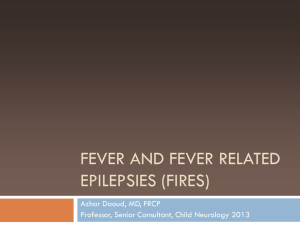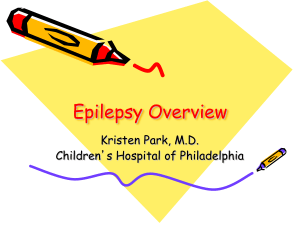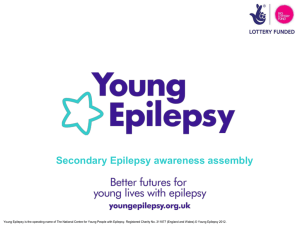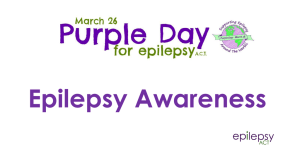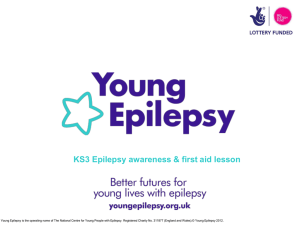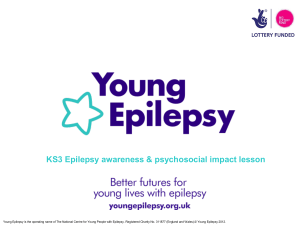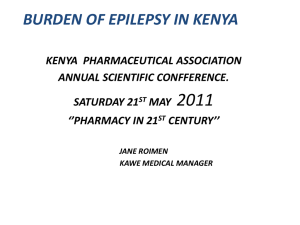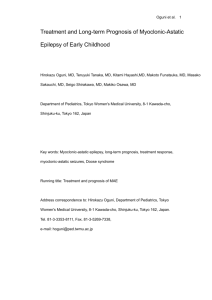ILAE Classification of Epilepsy
advertisement
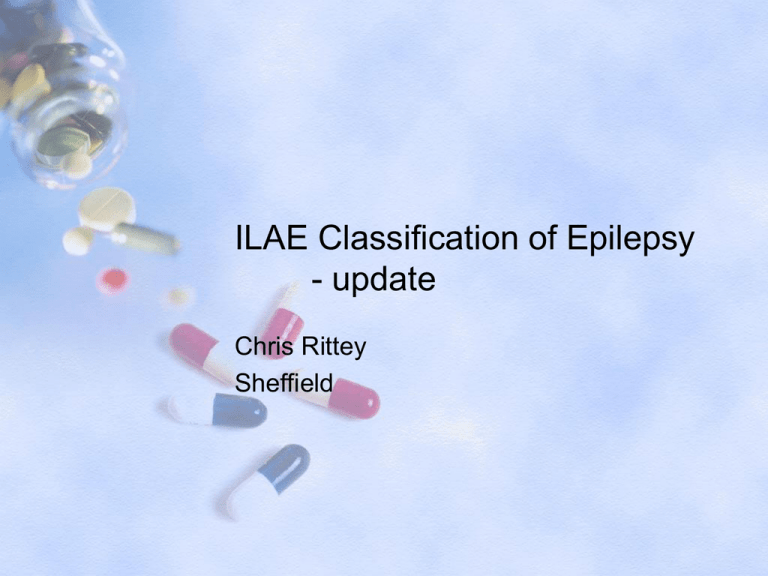
ILAE Classification of Epilepsy - update Chris Rittey Sheffield ILAE classification schemes • 1960 – first suggested ILAE classification • 1981 – seizure classification published • 1989 – syndrome classification published • 2001, 2006 – attempts at update 2010 • Revised terminology and concepts for organization of the epilepsies: Report of the Commission on Classification and Terminology • Developed as a methodologically and conceptually sound and meaningful revision to the classifications of 1981 and 1989 • Based on input from genetics, neuroimaging, therapeutics, paediatric and adult epileptology, statistics, research design What is a classification of epilepsy? • A list of entities which are recognised to be distinct forms of epilepsy • No new entities added since 2006 report • The concepts and structure underpinning that list • 1989 classification recognised as an organisation built on concepts rather than true classification • Accordingly the current organisation is being abandoned • Mechanism and process to determine which entities are included on that list and the features which characterise them – this needs to be agreed under new system Changes Seizure classification – generalised seizures • Considered to originate at some point within, and rapidly engage, bilaterally distributed networks • Networks can include cortical and sub-cortical structures but do not necessarily include the entire cortex • Individual seizures may have an apparently localised onset but location and lateralisation are not consistent from one seizure to another • Generalised seizures can be asymmetrical Seizure classification - focal seizures • Considered to originate within networks limited to one hemisphere • May be discretely localised or more widely distributed • May arise in sub-cortical structures • Ictal onset is consistent from one seizure to another for each seizure type • Preferential propagation patterns occur – may involve the contralateral hemisphere • There may be more than one epileptogenic network and more than one seizure type in an individual but each has a consistent site of onset Specific changes to 1981 schema • Neonatal seizures no longer regarded as a separate entity • Sub-classification of absences has been simplified • Myoclonic absence and absence with eyelid myoclonia now recognised • Epileptic spasms included in their own category • Generalised, focal, or of unclear onset Specific changes to 1981 schema • Distinction between different types (e.g. simple and complex partial) is eliminated – however importance of impairment of consciousness, localisation, ictal progression recognised as potentially important for individual patients • Focal seizures can be described using these concepts • Myoclonic atonic (myoclonic astatic) seizures now recognised • Category of unclassified epileptic seizures no longer accepted Classification strata I. II. III. IV. Classification of seizures Syndromes and epilepsies Aetiological designation Other dimensions IV-A. Age at onset IV-B. Natural evolution IV-C. Other features I. Classification of seizures GENERALISED SEIZURES FOCAL SEIZURES Tonic clonic (in any combination) Absence - typical - atypical - absence with special features - myoclonic absence - eyelid myoclonia Myoclonic - myoclonic - myoclonic atonic - myoclonic tonic Clonic Tonic Atonic MAY BE FOCAL, GENERALISED, OR UNCLEAR Epileptic spasms Descriptors of focal seizures • Without impairment of consciousness/responsiveness • With observable motor or autonomic components (corresponds to “simple partial seizure”) • Involving subjective sensory or psychic phenomena only (corresponds to “aura”) • With impairment of consciousness/responsiveness (corresponds to “complex partial seizure”) • Evolving to a bilateral convulsive seizure (involving tonic, clonic or tonic and clonic components) – replaces “secondary generalised seizure” II. Syndromes and epilepsies • Need to recognise the different levels of specificity between syndromes • In previous classification: • Some syndromes very specific and well differentiated e.g. CAE • Other syndromes very poorly differentiated e.g. cryptogenic parietal lobe epilepsy • New system attempts to explicitly acknowledge these differences Syndromes will no longer be characterised as being focal or generalised Classification ‘groups’ • Electroclinical syndromes • Epilepsy constellations • Epilepsies secondary to specific structural or metabolic lesions or conditions • Epilepsies of unknown cause Electro-clinical syndromes I • Complex of clinical features, signs and symptoms that define a distinctive, recognisable clinical disorder • Use of term “syndrome” will be restricted to a group of clinical entities that are reliably identified by a cluster of electroclinical and developmental relationships • Largely (not exclusively) genetic • Tend to have strong relationship to developmental aspects of the brain Electro-clinical syndromes II • Identifiable on the basis of: • Typical age of onset • Specific EEG characteristics • Specific seizure types and other clinical features • Diagnosis has implications for treatment, management and prognosis Epilepsy “constellations” • Epilepsy entities which are not syndromes per se but represent clinically distinctive collections of features • Often have implications for treatment, esp. surgical • Include: • Temporal lobe epilepsy (with hippocampal sclerosis) • Gelastic seizures with hypothalamic hamartoma • Rasmussen syndrome • Age at presentation is not a defining feature Epilepsies secondary to specific lesions or conditions • Lower level of specificity than previous groups • Previously defined on basis of localisation e.g. symptomatic temporal lobe epilepsy • Now recommended that emphasis is placed on the aetiology e.g. epilepsy with focal features secondary to focal cortical dysplasia in the temporal lobe • Now included in the classification within the group “Structural/metabolic epilepsies” Epilepsies of unknown cause • Includes all epilepsies previously known as cryptogenic • Account for 1/3 or more of all people with epilepsy • Probably need to move away from attempting to classify by interictal spike focus – replace with detailed description of relevant features: • Age at onset • EEG features • Cognitive/developmental assessment • Diurnal patterns of seizure occurrence • Will allow improved classification with time Electro-clinical syndromes and other epilepsies • Electro-clinical syndromes arranged by age at onset • Neonatal period Benign familial neonatal seizures (BFNS) Early myoclonic encephalopathy (EME) Ohtahara syndrome • Infancy Migrating partial seizures of infancy West syndrome Myoclonic epilepsy in infancy (MEI) Benign infantile seizures Benign familial infantile seizures Dravet syndrome Myoclonic encephalopathy in nonprogressive disorders Electro-clinical syndromes and other epilepsies • Childhood Febrile seizures plus (FS+) (can start in infancy) Early onset benign childhood occipital epilepsy (Panayiotopoulos type) Epilepsy with myoclonic atonic (previously astatic) seizures Benign epilepsy with centrotemporal spikes (BECTS) Autosomal-dominant nocturnal frontal lobe epilepsy (ADNFLE) Late onset childhood occipital epilepsy (Gastaut type) Epilepsy with myoclonic absences Lennox-Gastaut syndrome Epileptic encephalopathy with continuous spike-and-wave during sleep (CSWS) including: Landau-Kleffner syndrome (LKS) Childhood absence epilepsy (CAE) Electro-clinical syndromes and other epilepsies • Adolescence - Adult Juvenile absence epilepsy (JAE) Juvenile myoclonic epilepsy (JME) Epilepsy with generalized tonic-clonic seizures alone Progressive myoclonus epilepsies (PME) Autosomal dominant partial epilepsy with auditory features (ADPEAF) Other familial temporal lobe epilepsies Electro-clinical syndromes and other epilepsies • Less Specific Age Relationship Familial focal epilepsy with variable foci (childhood to adult) Reflex epilepsies • Distinctive Constellations Mesial temporal lobe epilepsy with hippocampal sclerosis (MTLE with HS) Rasmussen syndrome Gelastic seizures with hypothalamic hamartoma Epilepsies that do not fit into any of these diagnostic categories can be distinguished first on the basis of the presence or absence of a known structural or metabolic condition (presumed cause) and then on the basis of the primary mode of seizure onset (generalized versus focal). Electro-clinical syndromes and other epilepsies Epilepsies attributed to and organized by structuralmetabolic causes Malformations of Cortical development (hemimeganencephaly, hetertopias etc) Neurocutaneous syndromes (Tuberous sclerosis complex, Sturge-Weber, etc) Tumor Infection Trauma Angioma Peri-natal insults Stroke Etc. Electro-clinical syndromes and other epilepsies Epilepsies of unknown cause Conditions with epileptic seizures that are traditionally not diagnosed as a form of epilepsy per se. Benign neonatal seizures (BNS) Febrile seizures (FS) III. Aetiological designation • Withdrawal of concepts of idiopathic, cryptogenic and symptomatic • Three main aetiological groups: • Genetic - the epilepsy is the direct result of a known or presumed genetic defect in which seizures are the core symptom • Structural/metabolic – the epilepsy results from the structural or metabolic condition, not simply as a result of the genetic cause of the condition • Unknown cause IV. Other dimensions IV-A. Age at onset • Neonatal (< 44 weeks gestational age) • Infant (< 2 years) • Child (2-12 years) • Adolescent (12-18 years) • Adult (> 18 years) IV. Other dimensions IV-B. Natural evolution • Epileptic encephalopathy – can be used to characterise syndromes as well as individuals. Need to recognise that source of encephalopathy is usually unknown. • ‘Benign’ – key features • Seizures are self-limited i.e. spontaneous remission, regardless of treatment, occurs at an expected age and is the anticipated outcome • Seizures themselves are not disabling over the course of the active epilepsy – does not preclude subtle/moderate cognitive and behavioural consequences • Pharmaco-responsive IV. Other dimensions IV-C. Other features • EEG features • Imaging findings • Examination findings • Cognitive/behavioural issues • Etc. Current status of this system • No single specific organisation proposed for this classification • Individual epilepsy entities (regardless of specificity) should be organised as most relevant for the individual • May follow the same process used in 1989 classification, or a completely different set of criteria depending on their fitness for purpose e.g. according to specific underlying cause or lesion Summary • New proposed classification is recognised to be an evolutionary process • Several specific changes e.g. related to seizure classification, ‘electro-clinical syndromes’ • No ‘designated’ system for organising the classification – clinicians will need to determine most appropriate structure for individual patients • Current classification reflects current state of knowledge • No change to the list of recognised epilepsies

